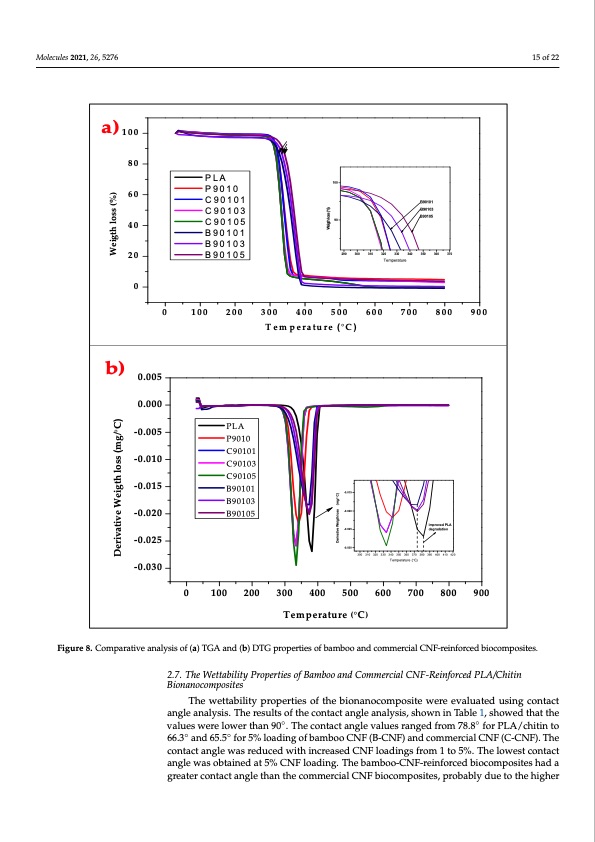
PDF Publication Title:
Text from PDF Page: 015
Molecules 2021, 26, 5276 temperature. These values probably show that B‐CNF reinforced biocomposites have bet‐ ter thermal stability than C‐CNF‐reinforced biocomposites [62]. However, both biocom‐ posites had percentage degradation values above 80% of the weight loss decomposition bility than when it is reinforced with C‐CNF, probably due to the difference between the crystallinity properties of the CNFs [64]. point of biocomposites [63]. PLA/chitin reinforced with B‐CNF has a higher thermal sta‐ 15 of 22 a)100 80 60 40 20 0 PLA P9010 C90101 C90103 C90105 B90101 B90103 B90105 0 100 200 300 400 500 600 700 800 900 Temperature (C) 100 90 290 300 310 320 330 340 350 360 370 Temperature B90101 B90103 B90105 b) 0.005 0.000 ‐0.005 ‐0.010 ‐0.015 ‐0.020 ‐0.025 ‐0.030 0 100 200 300 400 Temperature (C) 800 900 PLA P9010 C90101 C90103 C90105 B90101 B90103 B90105 -0.015 -0.020 -0.025 -0.030 300 310 320 330 340 350 360 370 380 390 400 410 420 Temperature (C) 500 600 700 improved PLA degradation Figure 8. Comparative analysis of (a) TGA and (b) DTG properties of bamboo and commercial CNF‐reinforced biocom‐ Figure 8. Comparative analysis of (a) TGA and (b) DTG properties of bamboo and commercial CNF-reinforced biocomposites. posites. 2.7. The Wettability Properties of Bamboo and Commercial CNF-Reinforced PLA/Chitin Bionanocomposites The wettability properties of the bionanocomposite were evaluated using contact angle analysis. The results of the contact angle analysis, shown in Table 1, showed that the values were lower than 90◦. The contact angle values ranged from 78.8◦ for PLA/chitin to 66.3◦ and 65.5◦ for 5% loading of bamboo CNF (B-CNF) and commercial CNF (C-CNF). The contact angle was reduced with increased CNF loadings from 1 to 5%. The lowest contact angle was obtained at 5% CNF loading. The bamboo-CNF-reinforced biocomposites had a greater contact angle than the commercial CNF biocomposites, probably due to the higher Derivative Weigth loss (mg/C) Weigth loss (%) Derivative Weigth loss (mg/ C) Weigthloss(%)PDF Image | Supercritical Carbon Dioxide Isolation of Cellulose Nanofibre

PDF Search Title:
Supercritical Carbon Dioxide Isolation of Cellulose NanofibreOriginal File Name Searched:
molecules-26-05276-v2.pdfDIY PDF Search: Google It | Yahoo | Bing
Sulfur Deposition on Carbon Nanofibers using Supercritical CO2 Sulfur Deposition on Carbon Nanofibers using Supercritical CO2. Gamma sulfur also known as mother of pearl sulfur and nacreous sulfur... More Info
CO2 Organic Rankine Cycle Experimenter Platform The supercritical CO2 phase change system is both a heat pump and organic rankine cycle which can be used for those purposes and as a supercritical extractor for advanced subcritical and supercritical extraction technology. Uses include producing nanoparticles, precious metal CO2 extraction, lithium battery recycling, and other applications... More Info
| CONTACT TEL: 608-238-6001 Email: greg@infinityturbine.com | RSS | AMP |